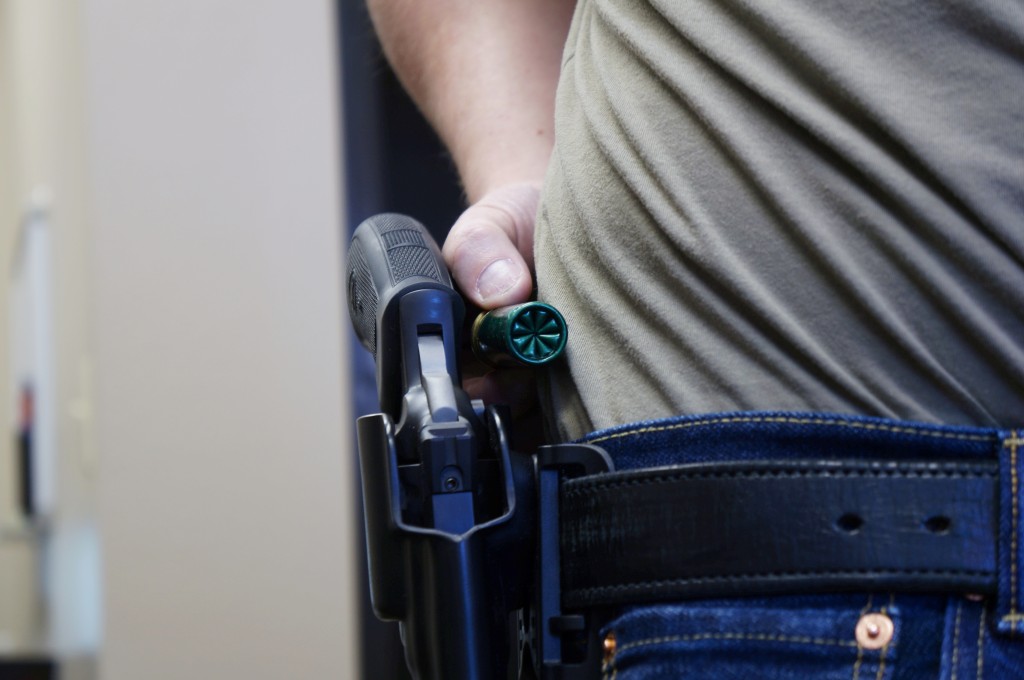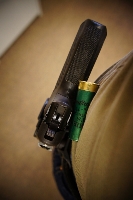When IDPA released the new rulebook, one of the sections that got major attention were the holster rules. It had always been a bit murky on what was legal or what wasn’t, so IDPA went to great lengths to clarify legal vs. illegal holsters.
8.5.1.17. For male shooters only, the holsters must fit the shooter’s body such that a ¾ inch/19.1mm diameter dowel placed between the shooter and the firearm anywhere above the belt contacts both the shooter and the firearm simultaneously.
If you’d like to test this at home, a 12 gauge shotgun shell is 0.75 inches in diameter. I decided to test my Blade-Tech holster to see if it was legal, and much to my dismay it wasn’t. This isn’t a knock on the gear, mind you – the way the rule is constructed is so that shooters of a certain body type will not be able to use holsters that other shooters who have a “width advantage” will be able to use. Here’s my currently illegal IDPA holster:

As you can see, the shell is nowhere near the gun, and even if I run it down closer to the top of my belt, it never contacts both the gun and my body at the same time. That leaves me with three options:
- Get a different holster
- Get fatter
- Modify my current holster by shimming/flattening the belt attachment
I guess there’s a fourth option, which would be “wear the illegal holster anyway and hope I don’t get caught”, but writing a blog post about it probably killed that one. My plan right now is to have Blade-Tech make me a different holster that would be IDPA legal, and then work with them to modify the existing holster so it’s closer to compliant with the rules.
Now, on to the rule itself: some would argue that this rule unfairly penalizes people who are skinny/fit by now allowing them to use these holsters. That’s a bunch of nonsense if you ask me. The rules are the rules, and if I can’t use this holster because my doughnut intake isn’t sufficiently high, than I’m okay with that. Using a tighter holster to the body gives up a few hundredths of a second on the draw, and while athleticism normally isn’t that important in an IDPA match, this is one case where I can make up 0.05 seconds by being a bit quicker.
So if you have a major IDPA match coming up, now’s a great time to check your gear. Grab a spare 12 gauge shell and make sure you’re within the 0.75 inch rule on your holster and magazine pouches, but only if you’re a dude. This rule doesn’t apply to the ladies because hips don’t lie or something.
Take note: here is the same model of Blade-Tech holster, but with a different gun, this time it’s a Sig P220. Note that this configuration on the same shooter is perfectly legal:

So far, the only holsters on which I’ve encountered the issue are the pictured revolver holster and one Comp-Tac 1911 holster. Just check your gear before your next match!

One thing, and it may not make a difference to you, but it will to some. When you pull your elbow back like that to try the shotgun shell test, you’re pulling your “love handle,” however little or much of it there may be, back with it. So you’re opening that gap to a little more than what it would be if your arm was at rest. The amount of change will vary based upon an individual’s size (in your case it doesn’t look like it would change the outcome; but I think it would in mine), but it’s there nonetheless.
The best bet is to have it tested by another person, which is what I did before taking the photo.
The new holster rules also fit the CCW principles of IDPA better. bigger people can conceal larger firearms and holsters better. A skinny person doesn’t have the same leeway when it comes to CCW. Just because a bigger persons firearm conceals well on him doesn’t mean that same firearm and holster will conceal well on someone smaller. That same setup would not be used for CCW by the smaller person.
On the other side of this debate: I’m 5’4″ and I use a G17 for IDPA but I run it in a Comp-Tac MTAC. I could obviously run a G34 if I wanted to.
A good point about the principle of IDPA. But if you talk about V-shaped people and not just O-shaped or I-shaped ones, that does not apply any more. Take someone with 10 inches more around the chest than the waist. With such a shape you can conceal nearly everything, because a normal shirt or vest hangs down straight from the chest. But to be effective you need a holster that moves the handle away from the body because your draw goes outwards the further you pull up due to the V-shape. That will never pass the dowel test, but does work really well for actual concealment.
I’d say the proper rule would be “it is judged whether the pistol could actually be concealed”. I get that no one likes that. Puts to much responsibility on the judge.
The 3/4″ rule also applies to ammunition carriers. I checked my speed loader carriers and to my surprise, the Ready Tactical carriers with Sadariland Comp IIIs were not legal if placed in front of my holster. If I placed them on my support side behind the centerline, they were fine. The holster belt loop pulls the belt away just enough to increase the distance between my body and speed loader. I use a support hand reload any way but I usually keep one loader in front of my holster for a reload with retention.
Maybe an “open carry analog” class is due? If you don’t have to worry about your jacket sticking out from your side that standoff doesn’t matter. Though they’d likely make the holsters require retention.
Damn. Option 2 was immediately appealing.
Finally, all you cheaters will pay and I will rule IDPA forever!
Hmmm,so THAT’S why IDPA has so many fat people. 😀
(JK IDPA guys, but with those rules, there’s got to be a little needling allowed from the USPSA section)
“Always, never, and must – these are the words of the unwise in the tactical world.”
-SGM Kyle Lamb (Ret.)
Time to break out the peanut butter and Nutella! Yum :oP
I’m marketing IDPA compliance belts, they are belly bands in three different thicknesses worn under your shooting shirt.
I also will be marketing a compliance device: a single-side (L or R, your choice) grip panel spacer. Available in quarter inch increments (.25″ and up)
“… between the shooter and the firearm ANYWHERE above the belt …”
Doesn’t this mean that 12ga shell can be put (by judge) between the body and gun near the very end of a grip?
In that case it’s possible that even your P220 can fail the test.
Just asking.